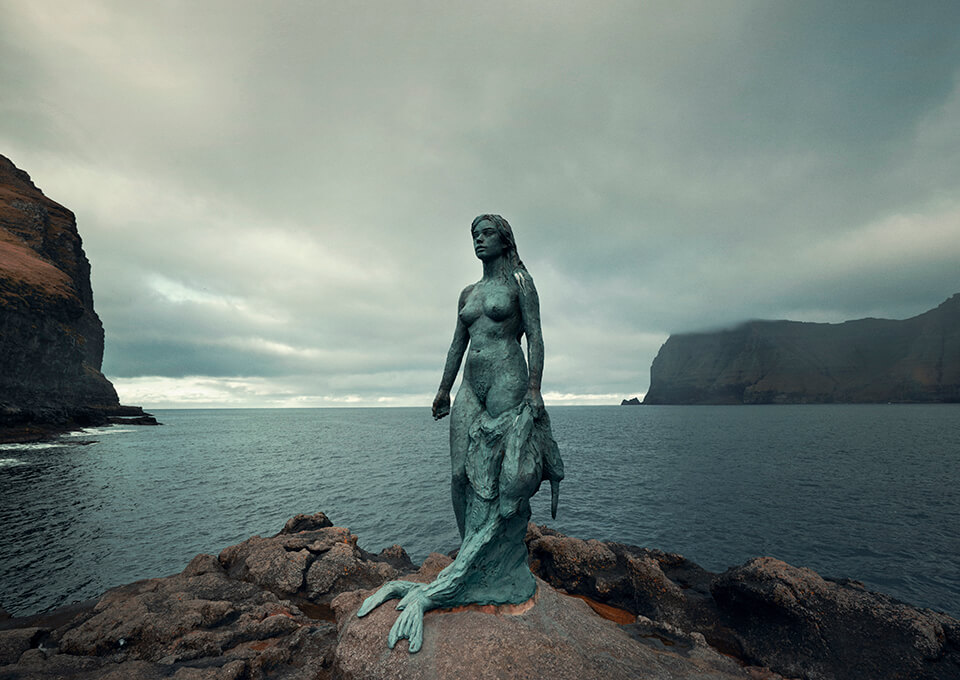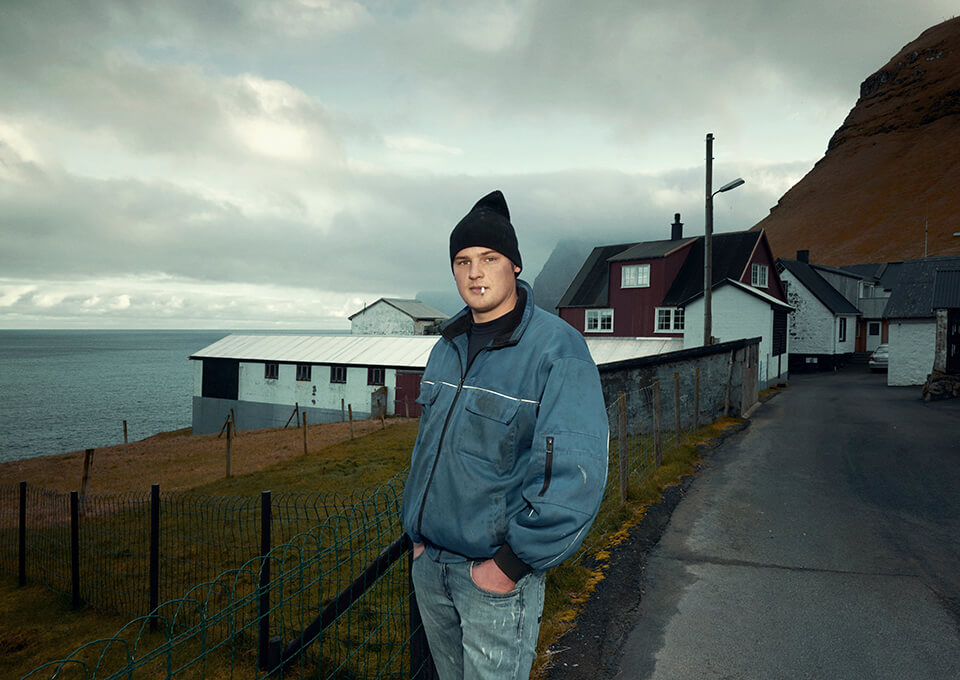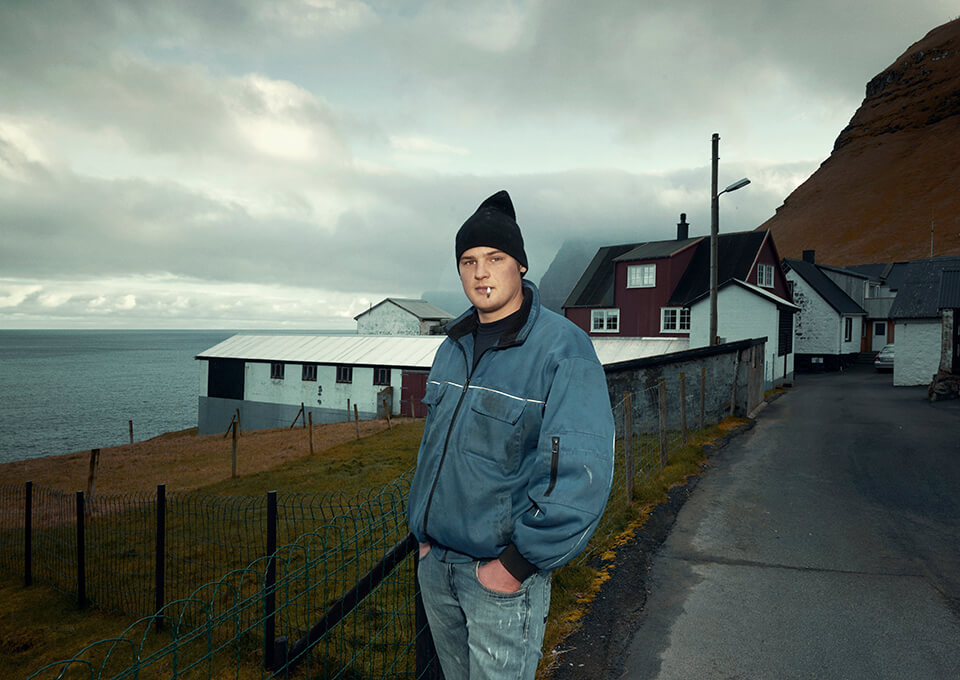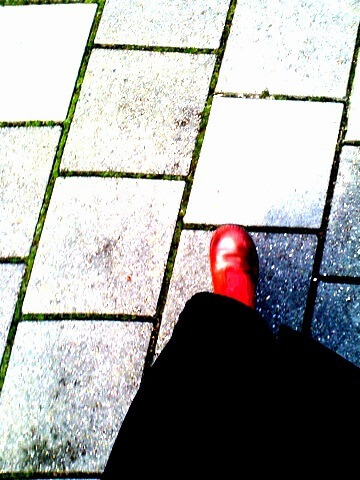How far away from civilization can you live and where do you feel at home? To the young sheep farmer Jóhannus, the centuries old village of Trøllanes on the Faroe Islands has it all. Just like it had for his ancestors who arrived 500 years ago. “What more does a man need?”
Trøllanes
As if living on the far most corner of an island in the middle of an ocean weren’t enough, two mountainous giants rise up from the sea, enclosing the hamlet even more.
It reminds me of the Icelandic thriller series Trapped. In the east of Iceland – an hour’s flight from where I am standing now – a village near the ferry port is snowed in. The passengers of the ferry and the villagers are condemned to each other and an intense cat and mouse game unfolds in which more and more people die.

Homicidal
Obviously I do not believe that the twelve inhabitants of Trøllanes are a homicidal lot. And according to Jóhannus, it rarely snows here. And on the rare occasion that it happens to snow, the police is called in to locate the snowplough.
No, it is the isolation of the place that makes me think of the series. Up till 1985 Trøllanes could not be reached by road. Whoever wanted to go there had to climb soggy hills or cross the water.
Jóhannus’ house, situated on the left just outside the village, splashes out of the bay, blood-red in colour. The colour of the Kallsgarð Joensen family. Even the shed with the carcasses and the bits of withered mutton are of the same colour. The other two families in the village content themselves with a sober grey or brown.
Colour seems to be of importance to Jóhannus. While my feet sink into marshy grass, fluorescent pink bottomed sheep frolic ahead of us. Jóhannus’ sense of humor. This way he can keep an eye on his ladies from the house. Pink can be spotted from afar. Actually, the sheep change colours all the time after being sheared. Red for the oldies – ready for slaughter – and green for the young lambs.
Faroe islands
We look down at the village and Jóhannus’ house. Situated in the land of Maybe, as the Faroe Islands are called because of the rapidly changing weather. The weather, however, is not bad at all.
Besides, it is the reason we stopped. “At this height”, Jóhannus explains, “the sun does not rise above the hill between the 1st of October and the 12th of March. During that period Trøllanes is deprived of sunlight.”
Once winter left
Exactly on the 12th of March the light falls back over the hill in the village. As a token of politeness the sun shines her first rays through the kitchen window of his grandfathers’ house. Jóhannus shrugs and laughs. “My grandpa was the first to now when winter left. Isn’t that wonderful?”
When we were given the name of the sheep farmer, I had an image. Even though it wasn’t very distinct, it was clear to me that this man, who was prepared to tell us about his life as a sheep farmer on the Faroe Islands, had to be middle-aged.
A belly and a beard
My image had a belly and perhaps a somewhat grubby beard. A sturdy wife and a few children. In my mind I had dressed him in overalls with the legs tucked into a pair of boots. When we asked a middle-aged woman in Trøllanes where to find Jóhannus, the image tilted. She smiled: “Ah, my grandson.” Jóhannus turned out to be a 22 year old boy. My son’s age.
A boy that pulls me courteously from the soggy grass whenever I sink into a rabbit hole. A boy who lives a ferry ride away from civilization in Klaksvik. Who has to brave a series of fjords and dark tunnels before he reaches home. A boy with a girlfriend who maybe watches Trapped on Netflix, as I do. “He lives there. In the red house”, his grandma had pointed out.
Mikladalur
The red house, boarded with timber from local trees, stands next to a former elementary school. The building still stands. It has become a public toilet. Now Japanese and Norwegians have a pee there when they visit the island in summer.
“They come to see the lighthouse”, Jóhannus says after we have settled into his kitchen. “They arrive in loaded ferries. Last year the captain tried to tally them but there were simply too many. You know what is curious? They always come to see the lighthouse or the seal-women Kópakonan in Mikladalur, the next village on. Never both. As if travel guides just always name one.”

Isle of Kalsoy
The kitchen looks out on the water. Somewhere between here and Iceland Jóhannus’ father is at work on a fishing boat. A career switch at the age of fifty made him exchange sheep for cod. The damp grass of Kalsoy for the humidity of the sea. His mother has answered to the call of politics in Klasvik.
Now that the other children have left the family home, Jóhannus governs the household himself. Not that it bothers him. He feels fine amidst his sheep and his ducks. “Animals and nature are enough for me. It is all I need.”
Drummer on the Faroe Islands
He pours a cup of coffee from the big thermos on the table. Of course he parties from time to time. And he plays the drums with the old folks from surrounding villages. They begged him to form a band.
Everybody on the Faroe Islands seems to play music. Now that he has joined them as a drummer, the oldies believe themselves to be young rock stars again. “And you know what?” This is what the island means to him: “a place where you are part of the community, no matter what age you are.”
It is all you need
“And that is enough, it’s all you need.” Enough are the twelve people with whom he shares the village. – Don’t be mistaken: he is one out of five still in their twenties. – Enough are his 40 ducks and enough are his 200 sheep.
He occasionally catches some birds on the rocks to complement its menu. “If you’re asking whether I’m rich I say, it’s enough to live on.”
My grandfather, the father of my father never did a day’s work.”He had seven sheep, a potato field and some rhubarb. Now and again he would barter with a fisherman in order to vary his diet.
He had foxes for their fur. He would exchange that for fodder for the animals.”
Svinoy en Fugloy
He pours another cup of coffee. For-y-ar. That is the name of the group of islands that includes his isle of Kalsoy. Of course there are jokes about the different islands. Like the one about Svinoy, the little island on the right of the archipelago, where they are poor, yet very clever, as everyone knows.
That doesn’t seem very clever I think, especially when I hear that the people of Fugloy, the island just above Svinoy, are rich and stupid. Jóhannus laughs.
Ambulance from Torshavn
When there is an accident, the ambulance comes from the capital of Tórshavn by ferry. A trip of an hour and a half including the ferry. In case of emergency a helicopter is called. “That doesn’t happen often. The people in the communities do a lot themselves. We depend on one another.”
He remembers only one visit from the police in all those years. They had to come from the main island Streymoy to Trøllanes. That was when the incident with the snowplough took place.
The shop in Klaksvik
It was the year that the snow stayed. Quite an unusual event, so the snowplough was called in. It arrived by ferry and was never seen again. The police was summoned. They found the snowplough in a niche in the tunnel with the driver fast asleep.
“Let’s go outside.” He shoves a rollie of the Dutch brand Niemeyer Jacobs between his lips. Everything he needs, including tobacco, he orders in Klaksvik. He knows the assortment of pizza’s by heart. The supermarket makes sure that it arrives on the first incoming ferry.
Lorry to Trøllanes
If he wanted to, he could decorate his complete house with goods from shops all over the Faroe Islands without ever leaving his home. Twice a week a lorry comes to Trøllanes. Full of animal fodder, food and whatever the villagers may have ordered. It is a free service. Designed to make people stay on the islands.

The islands have their own government and politicians like his mom. “Soon we will be independent from Denmark. We wanted to be, but we needed the money the country invested here. We need it less and less. Tourism is developing.
And by the way I find Danish an ugly language,” he says spitefully in the tone of the oppressed acting against those in power. I had told him that due to the many Danish series on tv, Danish language has become popular in Holland. “Our own language is closer to Islandic, softer.
No sound
Once outside, the ducks waddle towards us cackling loudly. “They are too heavy to fly,” the young farmer explains their funny gait. It is feeding time. A little bit further away the geese watch closely, waiting for the titbits.
There is no noise. Not from the wind, nor from the sea. The village in a void. This is what it must be like when you are deaf. Like this morning when an ambulance passed us. No sirens, just the flashing lights to remind us that somewhere on the island there was a person in need.

Finest ram
We go over to the sheep. The rams and the lambs are inside. The rams to prevent them from impregnating the ewes, otherwise the lambs are born too soon in the season. The lambs, because it is too cold.
One of the rams has a bow on its back. “That is a remainder of the competition last weekend,” says Jóhannus. He participated with his finest ram, who is now begging to be stroked by nudging his head. When the sheep are fed we climb up the hill that encloses the village on the east side.
Kallur lighthouse
Behind the hill hides the Kallur lighthouse. One of the most beautiful panorama’s of the Faroe Islands, according to the travel guides. We stumble up over the summit. From time to time my foot sinks in a wet gulley.
The photographer and Jóhannus lead the way. Jóhannus tells the story of the man he saved last year. A tourist went by himself over the ridge. He fell and broke his leg. The young farmer found him and called the helicopter.
Norwegian Sea
I decide to take a break and sit down on a stone. Over the summit, you can hear the ocean. Like a train who comes from afar. I don’t know if this is the Atlantic Ocean, or the Norwegian Sea. Somewhere in the black pool of water, the two meet.
From the cliff behind me white birds soar down. They make strange noises, like panting dogs. As if I am followed by a mob of hunting dogs. In the mountain across from me are enormous black imprints in the green grass. Like the heels of a giant dug in the sand.
Gjógv
“Wrong.” Jóhannus will tell me later. “This is where the sheep scratch themselves. The holes become bigger in spring and they grow back in winter.
I get up and walk up to the lighthouse. It stands on an isthmus between two bodies of water. To the west of the fjord, deeply into the bay, lies Gjógv where the famous musical G-festival takes place in summer. To the east lies Kunoy, but it is shrouded in the mist.
Outbreak of the plague
Jóhannus stretches his arms in both directions. The fjords, the ocean, the panting birds on the cliff. This is his world. Eight hundred years ago the first people came to this place. No one knows why. Was it because of the outbreak of the plague, were they on the run for someone or did they come to live off the many birds?
Jóhannus can trace back his family 500 years. They all lived in this village. A village that never really grows, nor does it get smaller. “It appears to have always been enough for all of them.”
“In any case it is enough for me.”
Text: Anneke de Bundel – Images: Nicole Franken
Translation: Adrienne le Brun – Hunkar
This trip was made possible by the fantastic support and knowledge of Susanna E. Sørensen and Levi Hanssen of Visit Faroe Islands.
More on the Faroe Islands? Read also:
- The ladies in the Faroe islands
- Faroe Islands, 9 things to know before you go
- Tórshavn, tips from locals
The Faroe Islands in facts:
- We flew in 2 hours from Copenhagen to Vágar with Atlantic Airways
- We rented a car via 62°N
- We slept in Hotel Foroyar



